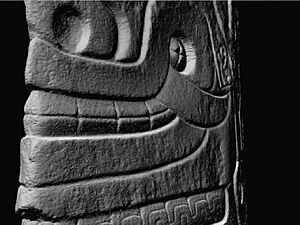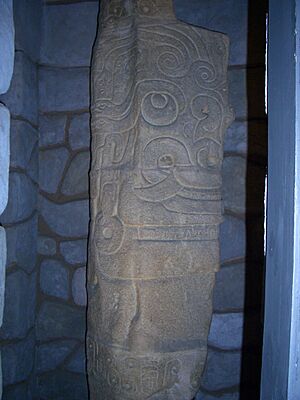Lanzón facts for kids
The Lanzón is a tall stone carving, like a pillar, made by the ancient Chavín people. It stands in the Old Temple at Chavín de Huántar, a famous ancient site in the mountains of Peru. The Chavín culture was very important in the Andes Mountains. Their religion and way of life spread widely from about 900 to 200 BCE. The Lanzón itself was put up around 500 BCE. Its name means "lance" in Spanish, but it looks more like a special plow used for farming back then. Because of this, many think the god shown on the Lanzón was connected to farming.
Contents
Where is the Lanzón Located?
The Lanzón is found right in the middle of Chavín de Huántar. This ancient site was built in a very important spot. It was on one of the few easy paths between the coast and the thick Amazon rainforest. Because it was hard to travel through the mountains, people had to use these paths.
This special location helped Chavín art, like the Lanzón, spread to other cultures. Archaeologists have found Chavín-style fabrics far away, even on the South Coast of Peru. This shows that the Chavín culture had a big influence on many other groups at that time.
What Does the Lanzón Show?
The Lanzón carving often shows a jaguar, which was a very important animal to the Chavín people. Sometimes these jaguars look real, and sometimes they look like a mix of a human and a jaguar. The Lanzón shows this human-jaguar mix.
Because jaguars appear so often in Chavín art, some experts believe the Chavín people worshipped them. They might have admired the jaguar's strength and other qualities.
Gods and Beliefs
The human-jaguar god on the Lanzón connects to other beliefs of the Chavín people and people across the Andes. One important idea was Camay. This meant that an object could hold a god's spirit. Even though the Lanzón was made of stone, the Chavín people believed a powerful god lived inside it. They even brought gifts like food and pottery to the Lanzón.
The Lanzón was also seen as an axis mundi. This means it was like a central pole connecting the sky, the earth, and the underworld. The god's arms on the Lanzón show this idea. One arm points up to the sky, and the other points down to the earth.
Balance and Opposites
The Chavín people also believed in duality, or the importance of opposites. Things like day and night, life and death, or male and female were seen as sacred. They believed these opposites created balance in the world.
You can see this idea of opposites in the Lanzón:
- The snakes and hair on the carving seem to change into each other, showing a transformation between human and animal.
- The site of Chavín de Huántar itself is located between the dry mountains and the lush Amazon jungle, showing a balance of different environments.
The Idea of Tinku
Another key belief in Andean society was tinku. This is the idea that different parts come together to create something completely new and powerful. The Chavín de Huántar site, where the Lanzón stands, is placed exactly where two rivers, the Mosna and Wacheqsa, meet. This meeting point was likely seen as a tinku, making the site even more special.
See also
 In Spanish: Lanzón de Chavín para niños
In Spanish: Lanzón de Chavín para niños



